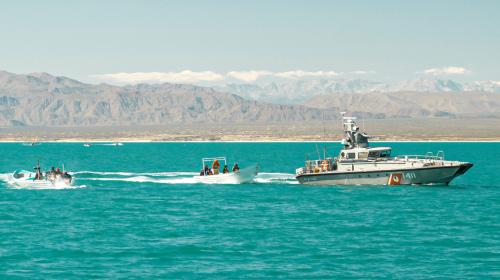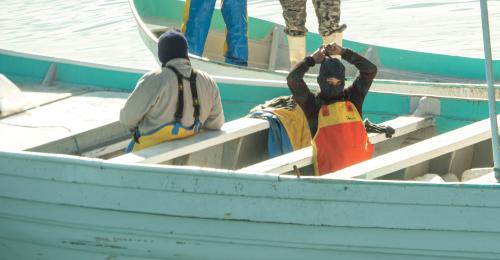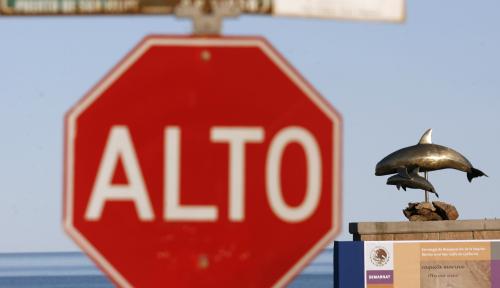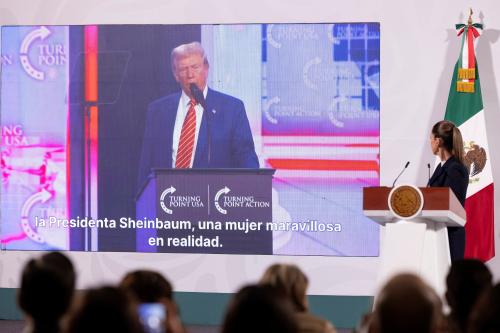Illegal fishing in Mexico is an extensive and growing problem, writes Vanda Felbab-Brown-Brown. Public focus has centered on the poaching of the totoaba in the Sea of Cortez, but illegal fishing in Mexico involves many other species and vast areas, she explains. This piece was originally published by La Reforma’s Mexico Today.
A major recent U.S. bust of a crime ring trafficking totoaba bladders and shark fins from Mexico to China highlights again that illegal fishing in Mexico is an extensive and growing problem. Public focus has centered on the poaching of the totoaba in the Sea of Cortez, where the almost-extinct porpoise vaquita marina dies in the gillnets of poachers. But illegal fishing in Mexico involves many other species and vast areas.
The Andrés Manuel López Obrador administration at first paid little attention to the issue. But it has come under intensifying economic sanctions pressure from the United States triggered by U.S. environmental NGOs’ lawsuits. In turn, President’s López Obrador’s party MORENA proposed strengthening and elevating the role of the Mexican Navy (SEMAR) in fishery’s enforcement, setting off a new controversy about the militarization of public policy domains in Mexico. Involving SEMAR in suppressing illegal fishing is inevitable, but alone it’s not a sufficient response.
Like elsewhere in the world, illegal fishing in Mexico threatens the productivity of fisheries and economic viability of that sector, basic livelihoods for artisanal fishers, sustainability of marine products, marine biodiversity, and food security. Like other illegal economies such as drugs, Mexico’s illegal fishing involves rings that smuggle the poached species to distant markets such as China; it also involves poor local fishermen that illegally harvest marine resources. Like drugs, it sets off conflict among and between local communities, and with Mexico’s regulatory and enforcement authorities, though the scale of violence is radically smaller than in the Mexican drug markets. Significant transshipment of the fish contraband takes place through the United States.
Mexico’s very long coastline and a fishing fleet involving over 100,000 small vessels, known as pangas, makes enforcement on the seas and on land that serves as launching places of fishermen challenging. Illegal fishing is estimated to account for between 45% and — a staggering — 90% of official fish production in Mexico.
Internationally, the most notorious case of illegal fishing in Mexico is that of a croaker fish — the totoaba — in the Sea of Cortez for its bladder that is highly valued in China and among Chinese and East Asian communities who without any actual scientific proof attribute curative Traditional Chinese Medicine (TCM) properties to it. The gillnets that the fishermen use to illegally capture the totoaba also entangle the vaquitas that rapidly drown, driving the marine mammals — of which perhaps only as few as 10 of these marine mammals remain — to extinction.
The harvesting of the sea cucumber off Yucatan in the Campeche Bank is equally pervaded by illegality. Promoted by the Mexican government in the early 2000s, the commercial fishing of the sea cucumber took off over the past decade without regulatory and management practices keeping apace. The arrival of trafficking middlemen who connected the fishermen with Chinese markets — where sea cucumber is a pricey, sought-after delicacy, with putative TCM qualities — turned the harvesting into a gold rush over extraction on the seas. For over a decade, the illegal fishing has been replete with massive illegality that ignored bans on harvesting. It has featured violent conflict among fishing communities, piracy as rival groups of fishermen seek to steal each other increasingly rare catch, and gave rise to local militias. It has been haunted by deaths and injuries to fishermen who take increasing risks and suffer decompression sickness. Law enforcement rapidly crumbled and has not overcome resources, prosecution, and corruption problems. The illegal fishing has led the collapse of the ecologically vital species serving to keep filtration roles in the ocean: the sea cucumber went from 20,000 tons available in 2009 to 1,900 tons in 2013, and fewer since. Some 1,000 sea cucumber poachers were believed to operate in the Campeche Bank in 2018.
Although Mexico’s prohibits the export of shark fins, large-scale shark poaching and fin trafficking takes place, with the fins heading to East Asia, sometimes (but not always) via the United States, such as in the recent bust. Other species to which illegal fishing has spread include red grouper, negrillo, and lobster. Tragically, some of them, such as octopus, were previously well managed. But the takeoff of illegality in fishing of species in an area spills onto others unless that illegality is stopped.
Mexico has been fortunate so far not to suffer illegal fishing from Chinese fishing fleets that have plagued Ecuador, including the precious Galapagos, Chile, and Argentina. Chinese fleets that fish illegally are no poor artisanal fishermen. Like Japanese and European fishing fleets that fish illegally around Africa, China’s illegal fishing fleets are armadas of hundreds of massive ships, even feared as a maritime militia for China’s territorial disputes. But they may yet come to Mexican waters: And if they do, they could in just a day decimate marine resources, such as the treasured great white shark population in Guadalupe Island Biosphere Reserve. A medium-size shark fishing vessel can poach 300 sharks in a day.
Fisheries management and enforcement in Mexico involves a complex and mostly ineffective tangle of institutions that tend to be under resourced, susceptible to corruption, and engage in buck-passing. Among the key institutions are the National Commission for Aquaculture and Fisheries (CONAPESCA), Procuraduría Federal de Protección al Ambiente (PROFEPA), as well as the SEMAR and the Federal, state, and municipal police forces. In protected areas, regulation and enforcement also involves the National Commission of Natural Protected Areas (CONANP). Well-meaning and dedicated officers get easily disheartened by the rock-bottom slashed budgets the López Obrador administration imposed, hollowing out already critically weak management, inspection, enforcement capacities — an institutional morass.
Strengthening SEMAR’s role in responding to illegal fishing is almost inevitable — at least in the short term. No other enforcement agency has a similar capacity on the seas. In the United States, it is the Coast Guard that acts against illegal fishing in U.S. territorial waters. In countries such as Indonesia that suffer from extensive domestic and external illegal fishing such as from Chinese and Japanese fishing fleets, it is the navy. SEMAR’s heavy role may be necessary to counter the threat of China’s massive and hefty illegal fishing fleet.
The fact that SEMAR can also act on land and against the bases of illegal fishermen and the hubs of smuggling networks is also an important advantage.
Dismantling the smuggling networks -the middle-level organizers who connect demand in faraway places, such as China, with poachers on the ground should become a key priority for Mexican law enforcement.
However, any force that SEMAR uses should be highly proportional, limited, and as a last resort. Crowd control may well be needed against angry fishermen that attack and torch down CONAPESCA facilities to reclaim their confiscated nets and boats. But all of SEMAR’s actions need to be guided by strict respect for human rights and due process.
In the long term, Mexico could consider splitting off the portion of SEMAR that functions as a de facto Coast Guard and making it a separate dedicated service.
Law enforcement responses should also include escalating fines for illegal fishing and (most importantly) fines that are multiples of the value of the illegal catch. But even a large fine will not work as an effective deterrent if it is applied sporadically. Only a high frequency of detecting and prosecuting illegal behavior with fines will discourage illegality.
Launching better technologies — such as a variety of aerial, land, and marine water drones and other sensors — is very helpful for law enforcement and to ensure sustainability of fishing. Significantly, increasing resource capacities of CONAPESCA, CONANP, and PROFEPA is crucial.
So is reducing corruption in those and other Mexican law enforcement agencies. In order to achieve it in fisheries, separating licensing from inspection is fundamental: Different agencies should be handling these two functions.
But it is also important to improve coordination among CONAPESCA, CONANP, PROFEPA, SEMAR, the federal, state, and municipal police forces, the National Guard, and customs in intelligence and data sharing, enforcement, investigation design and follow-through, and prosecution. There are many opportunities for enhancing collaboration with U.S. counterparts such as U.S. Fish and Wildlife, customs, and prosecutors.
Reducing corruption, bringing in technologies, and improving coordination, however, are no escape from much better resourcing of environmental management and protection agencies. As long as the López Obrador administration starves them of budgets, better environmental, fishery sustainability, and rule-of-law results won’t follow.
Addressing the economic realities and needs of fishermen is also critical. That means helping them to adopt sustainable fishing practices, use ecologically low-impact fishing gear, and develop alternative livelihoods such as ecotourism. In some parts of Mexico, such as Yucatan’s Sian Ka’an Biosphere, all of these elements successfully took off. Highly cohesive and strongly self-organized communities that managed to link up with Mexico’s formal law enforcement institutions such as SEMAR were even able to protect against outside poachers. Elsewhere, such as in the protected vaquita area of the Sea of Cortez, all of these dimensions have been failing for decades: Ecotourism did not take off. Fishermen do not like alternative gear not harmful to the vaquita; and they eagerly participate in illegal fishing even as they do battle with outside poachers arriving from other parts of Mexico. And sports fishing tourism has withered as beaches became soiled and littered.
Crucially, Mexico needs to promote public participation in fisheries management and environmental protection. Many fishing communities are organized — even if they support illegal fishing. Their voices need to be heard and integrated into public policy responses. Mexico also has a strong bank of marine biologists and environmental NGOs to draw on who have long sought to improve sustainability of fisheries and marine biodiversity protection. Their knowledge and expertise should be integrated in government responses to address illegal fishing in Mexico, improve the conditions its coastal communities and protect biodiversity.
The Brookings Institution is committed to quality, independence, and impact.
We are supported by a diverse array of funders. In line with our values and policies, each Brookings publication represents the sole views of its author(s).











Commentary
Illegal fishing in Mexico and policy responses
September 14, 2020